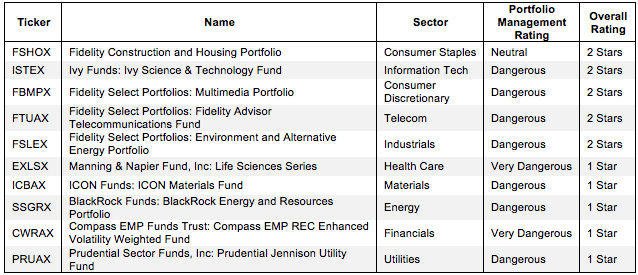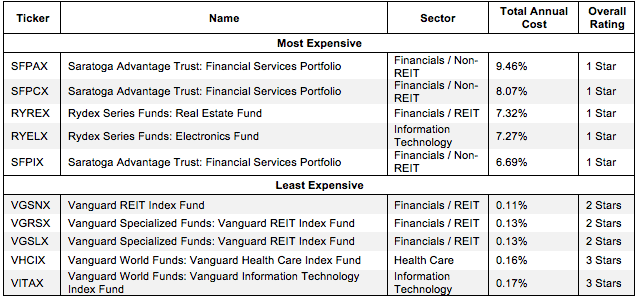Picking from the multitude of sector mutual funds is a daunting task. In any given sector there are up to 222 different mutual funds. There are at least 618 mutual funds across all sectors.
Why are there so many mutual funds? The answer is: because mutual fund providers are making lots of money selling them. The number of mutual funds has little to do with serving investors’ best interests. Below are three red flags investors can use to avoid the worst mutual funds:
- Inadequate liquidity
- High fees
- Poor quality holdings
I address these red flags in order of difficulty. More details on the best & worst mutual funds by sector are here.
How To Avoid Mutual Funds with Inadequate Liquidity
This is the easiest issue to avoid, and my advice is simple. Avoid all mutual funds with less than $100 million in assets. Low asset levels tend to mean lower trading volume and larger bid-ask spreads.
How To Avoid High Fees
Mutual funds should be cheap, but not all of them are.
To ensure you are paying at or below average fees, invest only in mutual funds with total annual costs (TAC) below 2.40%, which is the average TAC of the 618 U.S. sector mutual funds that I cover. If you weight the TACs by assets under management, then the average TAC is lower at 1.51%. A lower weighted average is a good sign that investors are putting money in the cheaper mutual funds.
Figure 1 shows the most and least expensive sector mutual funds in the U.S. equity universe based on total annual costs. Saratoga Advantage Trust and Rydex Series Funds offer the five most expensive funds. Vanguard, on the other hand, provides all five of the cheapest sector mutual funds.
Figure 1: 5 Least and Most-Expensive Sector Mutual Funds
Sources: New Constructs, LLC and company filings
While costs among ETFs fall into a generally narrow range, mutual fund costs are more varied. The high costs of the most expensive mutual funds, sometimes above 7% annually, make it much harder for them to perform as well as the cheapest mutual funds.
However, investors need not pay high fees for good holdings. Vanguard Consumer Staples Index Fund (VCSAX) is my top rated sector mutual fund overall, and it has a low total annual cost of 0.18%.
On the other hand, the Vanguard REIT Index Funds (VGSNX, VGRSX, VGSLX) hold poor stocks, each getting a 2-star or Dangerous rating. And no matter how cheap a mutual fund, if it holds bad stocks, its performance will be bad.
This result highlights why investors should not choose mutual funds based only on price. The quality of holdings matters more than price.
How To Avoid Mutual Funds with the Worst Holdings
This step is by far the hardest, but it is also the most important because a mutual fund’s performance is determined more by its holdings than its costs. Figure 2 shows the mutual funds within each sector with the worst holdings or portfolio management ratings. The sectors are listed in descending order by overall rating as detailed in my 1Q14 Sector Ratings report.
Figure 2: Sector Mutual Funds with the Worst Holdings
Sources: New Constructs, LLC and company filings
My overall ratings on mutual funds are based primarily on my stock ratings of their holdings. My firm covers over 3000 stocks and is known for the due diligence done on each stock we cover.
Fidelity appears more often than any other providers in Figure 2, which means that they offer the most mutual funds with the worst holdings. While none of these funds appear in Figure 1, their poor holdings offset their lower costs. Poor holdings can make for a bad fund.
Note that no mutual funds with a dangerous portfolio management rating earn an overall rating better than two stars. These scores are consistent with my belief that the quality of a mutual fund is more about its holdings than its costs. If the mutual fund’s holdings are dangerous, then the overall rating cannot be better than dangerous because one cannot expect the performance of the fund to be any better than the performance of its holdings.
Find the mutual funds with the worst overall ratings on my mutual fund screener. More analysis of the Best Sector mutual funds is here.
The Danger Within
Buying a mutual fund without analyzing its holdings is like buying a stock without analyzing its business and finances. As Barron’s says, investors should know the Danger Within. Put another way, research on mutual fund holdings is necessary due diligence because a mutual fund’s performance is only as good as its holdings’ performance.
PERFORMANCE OF MUTUAL FUND’s HOLDINGs = PERFORMANCE OF MUTUAL FUND
Best & Worst Stocks In These Mutual Funds
Applied Materials, Inc. (AMAT) is one of my least favorite stocks held by Rydex Series Funds: Electronics Fund (RYELX) and earns my Very Dangerous rating. It also is one of my Most Dangerous Stocks for February. Over the past seven years, AMAT’s after-tax profit (NOPAT) has decreased by 13% compounded annually. During this same timeframe, the company’s return on invested capital (ROIC) has declined from 25% to 5%. Despite this, the stock price of AMAT is up 34% over the past year. To justify the current share price of ~$18/share, AMAT would have grow NOPAT by 12% compounded annually for the next 17 years. For a company with declining NOPAT for almost a decade, these expectations seem beyond optimistic. Investors should avoid AMAT.
Qualcomm Inc. (QCOM) is one of my favorite stocks held by Vanguard World Funds: Vanguard Information Technology Index Fund (VITAX) and earns my Attractive rating. Over the past decade, QCOM has increased NOPAT by 23% compounded annually while increasing ROIC to a top quintile 51%, up from 19% in 2003. QCOM has also generated positive economic earnings every year for the past decade. Despite the growth of QCOM, the stock remains undervalued. At ~$76/share, QCOM has a price to economic book value (PEBV) ratio of only 1.3. This ratio implies the market expects QCOM to never increase NOPAT by more than 30% from its current levels. Given the company’s strong history of growth, this seems highly unlikely. Pessimistic expectations and a strong track record of growth make QCOM a good opportunity for investors.
Kyle Guske II contributed to this article
Disclosure: David Trainer owns QCOM. David Trainer and Kyle Guske II receive no compensation to write about any specific stock, sector, or theme.

